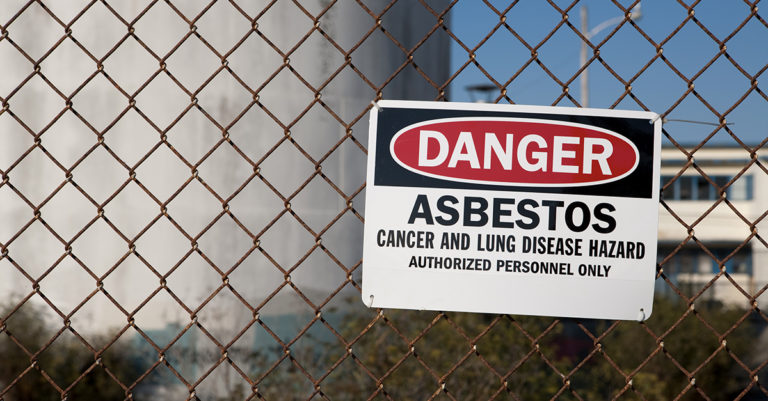Asbestos is the most lethal substance ever widely used in the workplace. Between 1940 and 1979 over 27.5 million Americans were occupationally exposed. Millions more were exposed when these workers’ brought this toxic dust home on their clothing, and many continue to be unknowingly exposed during demolition, construction and automotive work today. Asbestos use remains legal in the United States, and as recently as 2001, 26 million pounds were consumed in this country.
While workers and their families were breathing lethal asbestos fibers on the job and at home, those responsible for this tragedy worked feverishly to suppress information regarding its dangers. As early as the 1930s, industry studies indicated asbestos could cause lung cancer and a disabling lung condition called asbestosis. Instead of warning workers and looking for alternatives, organizations were formed to dispel any information revealing such hazards and to discourage regulation of its use.
As a result of the unprecedented reach of this toxic substance, approximately 10,000 Americans die annually from asbestos related disease-more than the number who die from cervical cancer. Studies indicate that between 1967 and 2030, 500,000 Americans will die from asbestos related diseases-more than the number who perished in World War II, Korea and Vietnam combined. This staggering disease crisis coupled with the conduct that caused it created the father of all mass torts.
Asbestos litigation
As a result of this staggering disease crisis, hundreds of thousands of victims have filed claims for both malignant and non-malignant diseases. Asbestos has been proven to cause mesothelioma, a cancer of the lining of the lung and abdomen who’s only known cause is asbestos, as well as lung, colon, esophageal, laryngeal and stomach cancers. Those not afflicted with malignancies can suffer from asbestosis, a scarring and fibrosis of the lungs which impairs victims’ breathing.
Other victims whose lungs show evidence of asbestos scarring but suffer no breathing impairment also file claims. These unimpaired cases are frequently forced to file suit to preserve their claim for fear that the statute of limitations will begin to run at the time they learned of their condition. This situation creates a dilemma for victims and their attorneys: file the case within the statute of limitations to preserve the claim even though the only current injury is fear of an increased risk of cancer; or wait until impairment develops with the possibility that the claim will be out of statute. Studies have estimated that 65-90 percent of pending claims involve unimpaired cases.
Asbestos cases are currently litigated in both federal and state courts. Cases filed in federal court have been consolidated by the Judicial Panel on Multidistrict Litigation in an MDL in the Eastern District of Pennsylvania. The MDL handles pre-trial matters and discovery before the cases are transferred back to the district court in which it was filed for trial.
At the state level, many courts have developed innovative case management procedures to expeditiously handle a large volume of claims. Just as in the MDL, these courts have often created separate asbestos dockets with consolidated discovery to streamline litigation costs and expedite case resolution. Through experience, these judges have developed a firm grasp of the issues that arise in asbestos litigation and a history and uniformity of rulings which create additional time and cost savings for litigants.
Both courts and state legislatures have fashioned various solutions to equitably handle the dilemma faced by unimpaired claimants. Many state courts, as well as the Federal MDL, have entered orders creating pleural registries or deferred dockets. Under these systems, victims who do not meet certain medical criteria are placed on a deferred docket and the statute of limitations is tolled until they become impaired. The rights of these claimants are preserved so that if they do develop cancer or breathing impairment, their claim may proceed. Similarly, Florida, Georgia, Ohio and Texas have passed legislation enacting comparable programs state-wide. Claims volume has decreased as a result.
Changing nature
At its inception, asbestos litigation customarily involved claims made by workers using asbestos in plants manufacturing asbestos products or construction tradesman using asbestos containing thermo-insulation and building materials. Traditional asbestos litigation focused on representing these tradesmen, whereas today’s litigators are seeing more mesothelioma claims among family members of these workers who were exposed to asbestos contaminated clothing. Ten and twenty years ago firms represented dad, and today they are representing the wives and children of these workers.
While many makers of construction materials such as pipe insulation, drywall and joint compound removed asbestos from their products during the 1970s, automobile brake and clutch manufacturers, including GM, Ford, and Chrysler, continued to sell brakes containing asbestos into the 1980s and 1990s. Many professional and shade-tree mechanics, therefore, were exposed to asbestos until rather recently, and they and their families comprise a significant number of current and future victims.
In recent years, the litigation has also focused greater attention on owners of premises that used asbestos containing products and materials. Many workers in oil refineries and chemical plants were not provided adequate safety precautions from the materials used at these plants, despite the premises owners’ superior knowledge regarding the dangers of asbestos use.
Pending legislation
For the last three years, the United States Senate has debated a trust fund scheme that would remove asbestos lawsuits from the court system. The legislation is currently called The FAIR Act and it seeks to create a $140 billion trust fund financed by defendant companies and their insurers to compensate victims who meet certain exposure and medical criteria. Under this bill, victims would not be permitted to sue, but would file a claim with a trust fund to receive a set level of compensation.
At first blush, this approach sounds like an equitable solution removing transaction costs, preserving resources to the sickest victims and providing speedy compensation. But, as is always true with any complicated piece of legislation, the devil is in the details. If the experience of other trust funds is repeated, victims can anticipate long waits, uncertain outcomes and a bankrupting of the fund.
The program’s funding serves as the first central problem plaguing the legislation. The proposed $140 billion funding level does not correspond to the potential costs of compensating victims but rather the amount that the business community has agreed to pay. Moreover, businesses have failed to reveal the firm’s that would contribute in order to estimate if the money will in fact be generated.
Assuming that the money will be collected, the massive number of pending claims will require in excess of $60 billion in the first few years. The program’s planned revenue stream, unfortunately, is spread evenly throughout the 30 year life of the fund. In order to pay the initial crush of claims, the fund will be forced to incur a massive debt that will be subsidized by the federal government. It is estimated that debt service costs could eat up $40-$70 billion of the program’s total funding. Any savings in transaction costs will, instead, be consumed by interest payments.
If the bill becomes law, all pending cases will come to a standstill during the one to two years necessary to go through federal rule-making procedures and establish the administrative system within the Department of Labor to compensate claims. During this start-up, victims will be trapped in purgatory: despite mounting medical bills and lost wages, they will be unable to pursue claims in court or in the trust fund. Hundreds of thousands of victims with pending claims will be left with nowhere to turn.
The total number of these current and future victims remains another central problem. Any projected fund must ensure that the program generates enough revenue to pay all legitimate claims. An accurate estimation of current and future claims remains essential to this goal. Without this information, the program cannot guarantee future claimants will receive compensation.
A brief glimpse at the history of claims projections in asbestos litigation demonstrates that all such attempts have grossly underestimated these numbers. At its inception in 1988, the Manville Trust anticipated between 83,000 and 100,000 future asbestos claims. The actual number of claims will between 13 and 32 times those original forecasts which required vast reductions in the amount of compensation to avoid bankrupting that fund. In an attempt curtail claims and ensure this program does not meet a similar fate, the legislation’s drafters have crafted medical and exposure criteria that disagree with those established by the American Thoracic Society and will exclude many legitimate claims.
In the end, only a small group of 30 to 40 asbestos companies will benefit by receiving a massive bailout. The enormous cost savings given to the companies with the greatest liability and culpability will be born by a much larger group of smaller companies who currently have adequate insurance to pay present and future claims. Not only will these smaller firm’s be forced to shoulder an inordinate share of the costs, they must do so after their insurance coverage is confiscated to fund the trust.
The ongoing debate over the legislation has also harmed victims by bringing the asbestos bankruptcy of some of the most culpable companies to a grinding halt. W.R. Grace, which is under criminal indictment for polluting Libby, MT and hiding the dangers of asbestos from the town, workers and consumers, and others have spent the last three years delaying the establishment of compensation trusts in the hope that they will receive a massive windfall under the legislation.
If the solution fails?
If the legislation fails and the program does sunset, asbestos defendants and victims alike will face adversity upon a return to the tort system.
Any trust fund failure will inevitably involve a bankrupting of the program after considerable debt has been incurred. In this environment, most asbestos defendants will be compelled to defend against claims without the benefit of their insurance coverage. The out of pocket payment of defense costs as well as claims will be incurred while these firms continue to make required contributions to the trust fund to retire its debt.
Most current asbestos defendants have the benefit of insurance coverage to defray the lion’s share of their costs. If these costs coupled with debt repayment are entirely born by companies, bankruptcy will be their only option. As more companies go bankrupt, the costs of debt repayment will fall to fewer and fewer entities and a cascading series of bankruptcies will ensue.
Victims, meanwhile, will experience increased delays upon any return to the tort system. Asbestos dockets will have been dissolved and new procedures must be created to ensure mesothelioma victims and others with short life expectancies may receive speedy trial dates.
Conclusion
With the implementation of pleural registries and inactive dockets at the state and local level, “the elephantine mass” of asbestos litigation is quickly coming under control. Many of the problems the FAIR Act sought to curtail have been remedied as the sickest victims are able to receive prompt compensation and asbestos defendants are seeing fewer claims. Enactment of the program at this stage would only produce greater suffering for the majority of victims and defendants. Victims cannot chance such a betrayal again.
{rss image} Subscribe Via RSS
Related Practices
Mesothelioma & Asbestos




